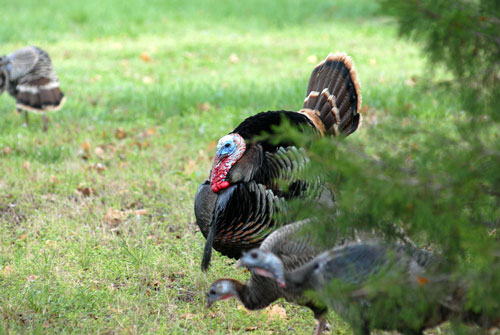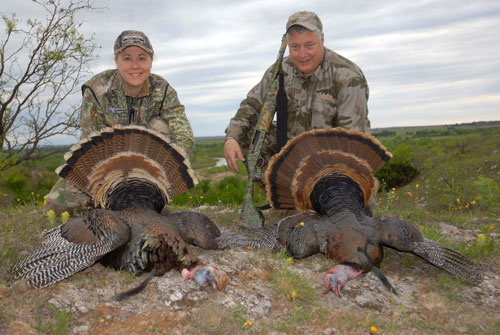 The distant pines swooshed in the breeze as their leaves hissed disapproval of the prevailing winds. In my experiences, wind and spring turkey hunting seem to go hand in hand, and this morning would be no different.
The distant pines swooshed in the breeze as their leaves hissed disapproval of the prevailing winds. In my experiences, wind and spring turkey hunting seem to go hand in hand, and this morning would be no different.
As the last dregs of dawn gave way to the anemic first rays of dawn, a song dog barked excitedly before howling in the distance. The coyote’s eerie call caused the distant trees to come alive, as roosted turkeys gobbled their condemnations. Individually, and in unison, the gobbling continued as the woods awoke with sounds unique to the outdoors.
As stealthy as a baby boomer can be, I set out a pair of realistic-looking turkey decoys before positioning a stubby-bearded jake closest to my blind. Hoping these dekes would authenticate my turkey calls, I set up my pop-up blind at the edge of a woodlot bordering a green field.
I climbed inside the blind and strained my peepers to see the distant roost trees. Lamenting about my over-50 vision, I could faintly make out the turkey silhouettes high in the distant trees. I knew the flock would fly down soon and assemble on the wheat field in front of me, just like their predecessors had done many years before. Though hunting eastern turkeys can be unpredictable at best, I felt confident that things would go my way this morning.
Reaching into my turkey vest, I grabbed my old box call and scratched out a few yelps, hoping to elicit a response from one of the toms. On cue, several gobblers gobbled; some even double-gobbled at my hen talk. Adrenaline coursed through my veins as I waited to lure a lovelorn longbeard into close range. I nervously checked my shotgun to make sure I had it loaded — a mistake I couldn’t afford to make.
Turkeys began to sail out of the towering trees, and many landed in the wheat field, not far away from my decoys. Soon the flock had assembled and three full fans peeled off towards my location.
I gloated over the simplicity of this hunt, knowing in seconds it would be hammer time. In a flash, things changed. The boss hen ran in yelping her dissenting views to the three philanderers, who relaxed from their struts and followed her back to the flock. The flock went in the opposite direction and my chip-shot turkey hunt went down in flames.
Turkey Hunting Can Be Unpredictable
A few years back my wife Donna tagged a dandy turkey — her biggest ever. The night before our hunt, we watched 75 gobblers go to roost, silhouetted in the tall cottonwoods, illuminated by the rising moon. We were serenaded that cool evening by the restless cacophony of lovelorn gobbles. Knowing we would be hunting a flock roosted a mere 400 yards from our cabin caused my night to be restless with anticipation.
Just before sunrise we set up near a gate where the roosted toms had been flying down, walking through, and then feeding and strutting on an alfalfa field. Soon, distant gobbling peaked with intensity, signaling the amorous toms would soon be on the ground and headed our way.
 As the darkness turned gray, I spied a dozen toms in full strut just out of range. Donna chided me to not scare the strutters off in my elation. She was hoping for the chance to handpick her gobbler from 20 yards away.
As the darkness turned gray, I spied a dozen toms in full strut just out of range. Donna chided me to not scare the strutters off in my elation. She was hoping for the chance to handpick her gobbler from 20 yards away.
Several respectable gobblers walked by before a fat, thick-bearded trophy caught Donna’s eye. I clucked to stop the curious longbeard and my wife dispatched the old tom with a well-placed load of 3 1/2-inch magnum No. 6s. The boss gobbler carried a 10 1/2-inch beard and weighed over 22 pounds.
Less than a half-hour later, I called up and shot a 2-year-old tom with a 9-inch beard. My wife and I had both scored on nice toms, and were headed home early.
Planting The Seeds For Success
Most of my turkey hunts are successful because someone took the time to plant a food plot that attracted the turkeys. Turkeys, like other wildlife, require three things to thrive: food, water and shelter. Food is one of the most overlooked but crucial aspects to a wild turkey’s survival.
Food plots provide turkeys with nourishment, safety from predators, places for toms to strut and breed hens, and a great place for the majestic birds to be social in general.
Planting a food plot can help you attract and hold turkeys, deer and other wildlife. Outdoor companies like Moultrie make planting and growing food plots a breeze, thanks to their spreaders and sprayers.
Before planting, biologists suggest to prepare the soil first, and then have your soil tested. The soil analysis will help you choose the proper fertilizer, which will allow for optimum growth. Popular crops for turkeys are wheat, sunflower, alfalfa, milo, clover, chufa and corn.






